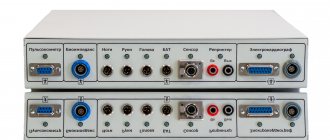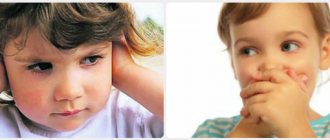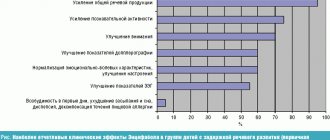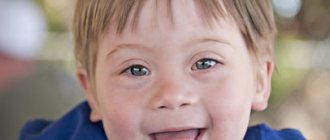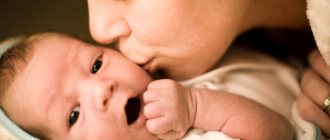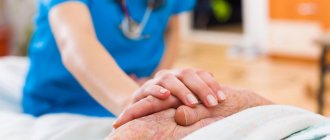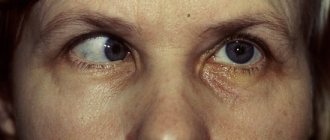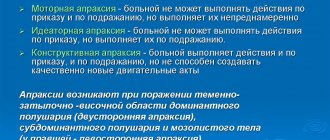microcurrent reflexology
Hello everyone, I'm new here. There will be a lot of words, but I’ll start with history to make it easier to understand the essence of the problem Vova’s story: Vova was born on April 18, 2013. I had terrible toxicosis throughout my pregnancy. The birth was on time, emergency c.s. The water-free period was almost 12 hours. In the maternity hospital there was jaundice, they were discharged on the 10th day, like everyone else after a c-section with us. Everything was fine, the child was developing, all vaccinations were according to schedule. There were delays in development - lying on his stomach, he began to hold his head confidently closer to 5 months, he began to sit up independently at 8 months, neurologists said that there was nothing wrong. They put paraffin on my neck and went to the pool to help me hold my head up. The child understood spoken speech, knew the animals horse and cow, and repeated them. You ask how a cow does it? The child mooed and clicked at the horse. He made faces in response, it was an imitation. He tutted at the horse. At 8 months they did an ultrasound of the head and found fluid, took asparkam and diacarb, everything became fine according to the neurologist. The child sat down on his own and I calmed down. The child continued to make faces, repeat, and understand speech. I constantly photographed him, there were many excellent emotional photos, the child looked into the frame, constantly smiling in the photo. They said mother, father, woman, child (Grandfather means), Roll-roll - we had a bicycle with a handle, in which we rode it around the apartment, since it was dirty outside. He played ladushki, you just tell him: “Vova, ladushki,” and the kid immediately clapped his hands. I went to 1.1 myself. The child showed interest and wanted to learn something himself. At 5 months, when I was feeding him from a bottle, he pushed my hand away and after that he learned to drink from a bottle himself and hold it himself. As he approached the age of one, he was reaching for the spoon himself, but I didn’t give it, I preferred to feed myself, since we lived with my mother-in-law, she constantly reprimanded me if the child littered somewhere. Somewhere after a year, problems gradually began, he stopped responding to his name, stopped making a horse and repeating, the child was whiny, stopped playing okay. What alarmed me most was that the child began to bang his head against the wall, there was always a bump on his forehead and a large bruise, then he began to refuse food: porridge, puree, soup. I only drank kefir or snow from a bottle. (To this day he still doesn’t know how to drink from a straw). And I just couldn’t take a picture of the child, he ran away, didn’t look into the frame, was constantly whiny, there are no such smiling photos anymore, he’s always with his back in the frame, or crying, breaking out of his hands. We turned to a neurologist. The neurologist examined me and said that the child was just spoiled, but to reassure me she sent me to a neurosurgeon so that he could resolve the issue of an MRI. The neurosurgeon also said that the child was healthy and they did an MRI. The MRI showed nothing, they reassured me that everything was fine with the child. The child never spoke, but I reassured myself: “He’s a boy, boys always start talking later, and in general everything is fine. So I lost a whole year of treatment. At this time I got a job in a taxi, the child was 1.3. I worked day and night 48. The child had someone to go with when I was at work. Sometimes dad was with him when he had a day off, sometimes his grandparents, sometimes he stayed with my grandmother, who is 70 years old. I threw myself into work, took on extra night shifts because I had personal problems, it was hard to live with my mother-in-law, and I set myself the goal of saving up for the down payment of a mortgage. I devoted little time to the child, yes, I saw that he was falling behind, but I blamed myself, and I still blame myself. He doesn’t know how to do this, because I don’t work with him, I don’t tell him anything. I worked in this mode for a year, took out a mortgage, and began to live separately. In September 2014 I sent my child to a regular kindergarten; he was 2.5. I really hoped for kindergarten, I’m always at work, and in kindergarten the teachers and other children will teach him something. But that was not the case, I saw in the kindergarten that he was very different from the other children, a week later we were dropped off from the kindergarten and politely asked to stay at home for a while. We went to another neurologist, did an EEG, this neurologist scolded us for performing an MRI under anesthesia. The EEG showed a very bad result, and also epi activity. We were immediately granted disability and started taking Depakine Chronosphere. Classes began, I took him to all the centers, some refused us even for money. I tried to study with the child myself, he does not listen to me, cries, bites, runs away, throws objects for study. We went to a geneticist, tested urine for gene changes, it didn’t show anything, the geneticist said there was nothing on my part, go ahead. The neurologist did not prescribe nootropics for a long time because of epi. In June 16, I just prescribed Pantogam. He was capricious from the pantogam, but he began to sit on the potty himself! This is a huge success for Vova, though he still sits on the potty in his pants, but that’s already something. I remember there was a moment when he didn’t even let me put him on the potty, immediately there was aggression. Therefore, I am very happy about this success. We completed three courses of microcurrent reflexology at the Samara rehabilitation center. We are going to the 4th course. Thanks to Samara, the child began to look more into the eyes, began to walk, before that he had not walked on the street with his feet, although he knows how to walk, he threw a tantrum, fell to be picked up. In general, he has become calmer, although there are huge behavioral problems. I didn’t begin to understand the speech, but little by little it seemed like understanding was beginning, and upon request, he could offer a hand. Speaks many syllables, but unconsciously. Sometimes he can say “give”, but very, very rarely. All requests are expressed in hysterics. When he wants to drink, he brings a mug into my hands. (there was a moment when he banged his mug on the table, which meant he was thirsty). He wants candy, brings me a candy wrapper, sometimes he unwraps it himself, sometimes he asks me. He does not eat with a spoon, he eats everything with his hands, and does not allow himself to be fed from a spoon. After every meal you have to wash the floor. He allows himself to be fed baby food with meat from a spoon. He doesn’t eat soup or porridge; he prefers to eat things that are convenient with his hands: pies, cutlets. Doesn't chew solid food, spits it out. We will be 4 years old one of these days. Today the child is aggressive, grabbing hair, pinching, biting both children and adults. For this reason, he does not attend kindergarten. We study at the children's assistance center, psychologist, speech pathologist, exercise therapy - every 2 times a week. The behavior continues to be terrible, and I don’t see any results in terms of behavior. What worries me most now is our behavior and that he is crumbling food. Please tell me what to pay attention to and what else to try to correct the behavior and speed up the recovery process? The trouble is that our city has an acute problem with specialists.
We are waiting for you!!!
Classes with a clinical psychologist using the “Floortime” method
Basic principles of classes with a psychologist using the “Floortime” method: 1. This is an approach that puts the child himself and his characteristics at the forefront. 2. The goal of “Floortime” is not only to achieve superficial success in the form of extinguishing certain symptoms and developing the child’s skills of socially acceptable behavior, but above all the development of the child’s personality. 3. The central part of the method is the process of increasing “communication cycles”. They are also called communication cycles or communication circles. 4. The main hypothesis of “Floortime” – by successfully working with a child’s emotions, you can create a basis for the development of his intelligence, communication skills and sympathy towards other people. 5. The interests of the child are paramount. The Floortime method focuses on games that interest the child. Thus, following the child’s initiative is the main goal in the game. 6. The best contact is through playing together. Playing together helps a child establish better contact with people around him, which will improve communication skills and increase interest in other people. 7. By entering the child’s world and sharing his interests, involve him in a shared space with an adult, raise him to the next level of development, endowing him with new knowledge and developing each of his functional levels. To assess achievements, parameters such as emotional warmth, the ability to build relationships with people, and the ability to communicate meaningfully and creatively are highlighted. The emotional development of a child has its own stages and age norms. Floortime considers age indicators from 3 months. up to 21 years old.
- The main task is to help the child take initiative for the emotional development of the individual.
- How are classes going? At the initial stage, the specialist determines the stage of the child’s functional-emotional development. Based on these data, the specialist involves the child in spontaneous play, following him, using previous knowledge about interests, inclinations and starting from the individual sensory profile of each child and promoting the development of those stages of emotional development that are not formed in the child.
- The goal is meaningful communication, strengthening or advancing through the stages of functional emotional development, identifying the characteristics of information processing, as well as sensory, motor and speech development.
Efficiency
Indications for microcurrent reflexology are most often delayed psychomotor development. It is also actively used in children with cerebral palsy as a complex treatment along with other methods. The technique goes well with pine baths, general massage, speech therapy massage of the facial area, as well as drug therapy.
As a result of rehabilitation and treatment with microcurrent therapy, the following is noted:
- reduction of hysterical manifestations, aggression and rapid excitability;
- improving the quality of memory and attention;
- improved sleep;
- increased motor activity due to decreased muscle tone;
- expansion of vocabulary in children;
- improvement of diction.
Strength of effect
In studies, magnetic therapy has a greater effect on the nervous and cardiovascular systems. Main effects were associated with decreased pain, anxiety, and improved quality of life. That is, if the problem contains one or more of these components, a positive effect may be noted.
To be satisfied with the result, you cannot have high expectations. Since the mechanism of action of the magnetic field on the body is quite difficult to perceive, misconceptions may arise, the image of a “magic pill” or hope for a miraculous healing may be formed when doctors could not help. Physiotherapy is always combined, and although it may be an important part of treatment, it will not be the only one. A typical example would be the image of an overweight person with knee pain. Courses of anti-inflammatory drugs help with varying degrees of success. One of the key reasons is excess weight, which leads to pain. Buying a device without adjusting your lifestyle and losing weight is unlikely to give the desired effect.
First, you should consult a specialist, follow the recommendations as much as possible, and then with peace of mind you can supplement this with magnetotherapy at home.
Colposuspension according to Birch
It consists of suspending the tissues surrounding the urethra to the strong structures of the anterior abdominal wall - the inguinal ligaments (Cooper). The operation is performed via abdominal access (through the abdomen). Surgical approach: either open or laparoscopic. For a long time, this operation was considered! "gold standard" in the treatment of stress urinary incontinence in women.
With the advent of operations to install a synthetic midurethral sling, Birch colposuspension lost its position.
Its long-term effectiveness “in capable hands” is up to 70-80 percent. The main disadvantages of this technique are: the need for anesthesia with artificial ventilation and the strong dependence of the results on the qualifications of the surgeon.
Conclusion
Microcurrent reflexology for children, according to many parents, is absolutely painless. Many children positively perceive the effects of microcurrents. The effectiveness of the technique is excellent, and there are practically no contraindications.
It is used both independently as treatment and in combination. Speech therapists often resort to microcurrent reflexology in their practice. Also, cerebral palsy is treated not only with massage, but also with this technique. Which overall gives a very positive result.
cost of treatment
The cost of treatment in our center is calculated individually, depending on the severity of the disease, its duration and the presence of complications.
Each patient is prescribed comprehensive sequential treatment in the form of a course of individually selected procedures.
In addition to the procedures, the treatment course includes a free follow-up appointment.
Initial and repeat appointments, as well as medications prescribed by a doctor, are paid separately. The cost of the initial appointment is 3,000 rubles.
A 10% discount is provided for a one-time payment for a treatment course.
Contraindications and restrictions
There are practically no contraindications to microcurrent reflexology, but there are some limitations. An important aspect when carrying out the technique is the condition of the child, since exposure to microcurrent can give a negative reaction.
The technique is contraindicated in the following cases:
- psychosis in the active stage;
- tumor processes in the body, regardless of their nature (benign or malignant neoplasms);
- diseases of the liver, lungs, heart, kidneys in acute form;
- ARVI or any infections;
- children up to 6 months from birth;
- pustules or inflammatory process on the skin;
- tuberculosis.
It should also be taken into account that the technique, although in rare cases, can cause shock, collapse or allergic manifestations. To prevent this, a specialist must not only conduct a thorough diagnosis of the baby’s condition, but also check his medical history.
How is the procedure performed?
Microcurrent reflexology for children, reviews of the effectiveness of which in most cases confirm its effectiveness, is carried out for from half an hour to 60 minutes. The child lies on the couch all this time, and electrodes are connected to his body. The minimum current connection area depends on the nature of the baby’s pathology. The generator produces ultra-low current electrical impulses that are incapable of harming the body and are not felt at all.
Microcurrent therapy is usually prescribed in a course that lasts on average up to 20 days. But for some advanced pathologies, treatment takes much longer. Therefore, the selection of the number of sessions is purely individual.
